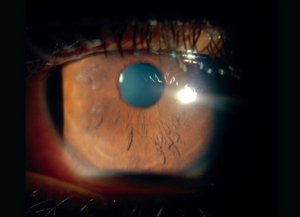Erythema multiforme minor
| Erythema multiforme minor | |
|---|---|
| Other names: EM | |
 | |
| Slit-lamp photograph of the right eye in diffuse illumination showing disappearance of the corneal lesions following treatment | |
| Specialty | Dermatology |
Erythema multiforme is usually a reaction of the skin and mucous membranes that occurs suddenly. It appears as a symmetrical rash and may include the mucous membrane lesions. This means that the body is sensitive to something that causes the skin and mucous membranes to react. The more common mild form is refer to as EM minor. It consists of a skin rash that involve no more than one mucosal surface. The sudden onset will progress rapidly as symmetrical lesions with circular color changes in some or all of the lesions. Rash will spread towards center or trunk of the body. Evenly distributed bumps on the skin become classic iris or target lesions. They have bright red borders and small white bumps in the center. The cause of EM appears to be a highly sensitive reaction that can be triggered by a variety of causes. The causes can include bacterial, viral or chemical products, such as antibiotics – specifically penicillins or cephalosporins. This reaction is an allergic reaction and is in no way contagious. [1]: 140
Erythema multiforme minor is sometimes divided into papular and vesiculobullous forms.[2]
See also
References
- ↑ Andrews' Diseases of the Skin: Clinical Dermatology. (10th ed.). Saunders. ISBN 0-7216-2921-0.
- ↑ Daniel J. Trozak; Dan J. Tennenhouse (1 October 2005). Dermatology skills for primary care: an illustrated guide. Humana Press. pp. 161–. ISBN 978-1-58829-489-0. Archived from the original on 21 June 2013. Retrieved 5 June 2010.
External links
| Classification |
|---|